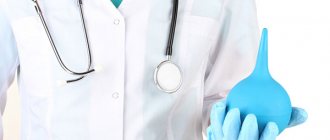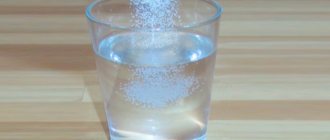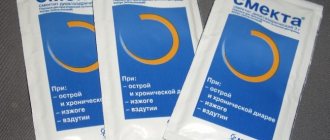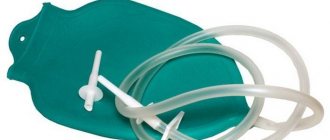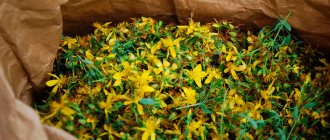| What can replace an enema? | Description |
| Activated carbon | To cleanse the intestines at home, you can take activated carbon at the rate of 1 tablet per 10 kg of body weight. |
The drug should be taken 2 times a day after meals with plenty of water. Colon cleansing will be gentle and painless.
The kefir diet is most often recommended. A glass of kefir should be drunk every hour.
It is necessary to calculate the correct dosage of the product - you will need 1 g of product per 1 kg of body weight. You need to drink castor oil warm.
They help cleanse the intestines, but often require several procedures, which is not always convenient.
An enema is a special procedure performed for the diagnosis and treatment of parts of the rectum. Manipulation can be carried out to normalize stool if there is a long absence of stool. An enema is prescribed before a number of diagnostic studies to obtain reliable data.
At home, many people prefer to cleanse the intestines on their own, because there are a number of effective alternative options that can replace an enema.
Contraindications
- gastrointestinal bleeding;
- intestinal obstruction;
- acute inflammatory processes of the colon, anus;
- the first days after surgery on the gastrointestinal tract;
- rectal prolapse;
- bleeding hemorrhoids;
- acute appendicitis;
- peritonitis;
- malignant neoplasms of the rectum;
- pathologies of the cardiovascular system.
The feasibility of the procedure is determined by the doctor.
Preparation for the event
Inventory
Before the procedure, prepare materials and instruments. Would need:
- oilcloth (approximately 150*100 cm);
- basin;
- napkin;
- balloon bulb (syringe);
- hydrogen peroxide 3% (if using a bulb with a hard tip);
- petrolatum;
- enema solution (prescribed by a doctor);
- sterile gloves.
For a cleansing enema, it is better to take a balloon bulb with a long tip (10–15 cm). Since it is recommended to administer 1–1.5 liters of liquid for a complete bowel movement, it is better to take a syringe with a volume of 470 ml (for a salt, oil, emulsion enema, 100–200 ml is enough).
Boil the pear for 10–15 minutes before use. If the tip is hard, remove it and soak it in a 3% hydrogen peroxide solution for 15 minutes. Then it is connected to the bulb.
Preparing your workspace
It is better to do the enema while lying on your side, and then remain in a lying position for at least 10 minutes. Therefore, you should prepare the place where the procedure will be performed.
An oilcloth is placed on the bed so that one end hangs from the bed (a basin is placed under it). The oilcloth is covered with a diaper.
Prepare an enema solution. Place it near the bed so that it is convenient to draw liquid into the syringe without changing position.
Enema solutions
Various solutions are used for cleansing enemas. The temperature of the liquid should be 22–23 ° C, or 36–38 ° C. The cold solution enhances intestinal motility and is prescribed for atonic constipation. Warm – relaxes, relieves spasms. If it is necessary to cause severe intestinal irritation, it is recommended to use liquid cooled to 12–20 ° C.
- saline;
- soda;
- herbal;
- oil;
- emulsion;
- potassium permanganate.
Even boiled water is used for enemas.
Which solution to choose depends on the disease and the purpose of the prescribed procedure.

Saline
Hypertensive enemas effectively cleanse the intestines. They help remove a larger volume of fluid, soften stool, stimulate the release of loose stools, and enhance intestinal motility. Apply:
- 10% sodium chloride solution (10 g of table salt per 100 g of water);
- 20–30% solution of magnesium sulfate;
- 20–30% sodium sulfate solution.
The procedure requires 100 ml of solution. It is heated to 37–38 °C. After administering the liquid, it is not recommended to stand up for 20–30 minutes.
It is contraindicated for ulcers, anal fissure, acute inflammation of the lower part of the large intestine, and edema.
Soda
Soda solution is prescribed for increased acidity of stool. It helps relieve pain caused by irritation of the intestinal mucosa with liquid feces during diarrhea. It is believed to be effective in the treatment of helminth infections. Recommended for cleansing the intestines with acetonemia.
To prepare the solution you need:
Sodium bicarbonate is dissolved in warm water. To cleanse the intestines, 1–1.5 liters of liquid are administered. The solution temperature should be 37–38 °C.
Herbal
Herbal infusions are recommended for cleansing enemas. Prescribed:
- Melissa infusion. Crushed shoots (3 g) are poured with a glass of boiling water and left for 20–30 minutes. Strain thoroughly. A warm solution (37–38 °C) should be administered. This enema relieves spasms.
- A decoction of flaxseed (oats, barley) and mallow leaves. The collection (1 tbsp) is poured into 1 liter of water. Boil for 10 minutes, filter, add 1 tbsp. l. salt, 2 tbsp. l. oil (linseed, hemp). I use this enema as a laxative for chronic constipation.
- Chamomile decoction. Chamomile flowers (6 tablespoons) are poured into 0.5 liters of boiling water. Place in a water bath and boil for 15 minutes. Allow the broth to cool, filter, and squeeze out the remaining raw materials. Add boiled water to the resulting broth to a volume of 0.5 liters. Add 2 tbsp. l. honey. This solution not only cleanses the intestines, it is anti-inflammatory and antibacterial.
Decoctions should be prepared in enamel containers. It is better to buy plant raw materials at a pharmacy or collect them yourself (away from railways, roads, and factories). It is strictly not recommended to buy herbs by hand, as they could have grown in contaminated areas and harmful substances have accumulated in them.
Herbal enema solutions should be used only as prescribed by a doctor and with extreme caution - they cause allergies.
Oil
Used to empty the lower part of the colon from feces and gases during spastic constipation, in the postoperative period, after childbirth. This is a long-acting enema. After it you should lie down for at least 8 hours. Therefore, it is better to put it before bed (the act of defecation should occur in 10–12 hours).
The oil has the following effects:
- Mechanical. The solution penetrates between the feces and the intestinal walls. The feces soften and are easily excreted.
- Chemical. The oil in the intestines is partially broken down and saponified. It relieves spasms and helps restore normal peristalsis.
To prepare the solution, take 100–200 ml of vegetable oil (linseed, hemp, sunflower, corn). It is heated to 36–38 °C.
An oil enema is prescribed for a gentle cleansing of the intestines, when it is undesirable to strain the muscles of the perineum, abdominal wall, or strain. Its contraindications are the same as for all types of enemas.
Emulsion
It is recommended for seriously ill patients. Prepare an emulsion enema as follows:
- Prepare 0.5 ml of chamomile infusion. Chamomile flowers (4 tbsp) are brewed in 0.5 liters of water. Strain, squeeze out the remaining residue, add water to a volume of 500 ml.
- Take 1 yolk. Beat thoroughly. Add 1 tsp. baking soda.
- The yolk is mixed with chamomile decoction. Add 2 tbsp. l. Vaseline oil or glycerin.
When using an emulsion enema, bowel movement occurs within half an hour.
Potassium permanganate solution
For an enema, use a slightly pink solution of potassium permanganate. 4–5 crystals of potassium permanganate are dissolved in 1.5 liters of water heated to 36–38 °C. A more concentrated solution, instead of benefit, will cause irreparable harm (burn of the mucous membrane).
An enema with potassium permanganate is prescribed for treatment:
- diarrhea;
- hemorrhoids (if there is no bleeding).
To cleanse the intestines, it is better to use other solutions, since potassium permanganate dries out the mucous membrane and causes additional irritation.
Description of compositions
The home method of cleansing using solutions should be selected in accordance with the doctor’s recommendations. Cleansing is carried out according to this recipe.
Salt and soda
The solution is made in the following proportion: 10 g table salt / 100 g water (10%). Use 20-30% solutions based on Mg and Na sulfate.
The water is heated to a maximum of 38 0C. After the procedure, it is recommended to lie down for half an hour. Contraindications: peptic ulcers, cracks, acute inflammatory reactions and swelling.
Soda solution is prescribed to relieve pain when stool has a high level of acid content. The proportion of the solution is 1.5 l. water / 50-60 g of soda at a temperature of 37-38 0C.
Traditional medicine gives three ways to prepare herbal infusions. It is recommended to cook in enamel pans, prepare the collection yourself (away from the highways, railways) or buy it at a pharmacy. Be careful when using herbs - allergic reactions are possible!
Melissa infusion against spasms: 3 g of plant per glass of boiled water. Let it brew for half an hour. Temperature 37-38 0C.
Decoction of flaxseed (oats, barley) and mallow leaves: 1 tbsp. l. / 1 l. water, bring to a boil (10 minutes) and strain. Add ingredients: 1 tbsp. l. salt, 2 tbsp. l. oils Used for frequent constipation.
Chamomile decoction: 6 tbsp. l. / 0.5 l. boiling water, place in a water bath for 15 minutes. Strain and squeeze out the resulting raw materials. Add an additional 0.5 liters. and 2 tbsp. l. honey. An excellent remedy for combating inflammatory processes and harmful bacteria.
Used to achieve emptying of feces and gases in the large intestine. The enema used lasts for a long time. After the procedure, it is better to lie down for up to 8 hours. Therefore, cleanse before bed.
Oil affects the intestines mechanically (softening of stool) and chemically (breakdown of matter, appearance of soap). The substance is heated to the maximum limit in an amount of 100-200 ml.
An oil enema is recommended as a softening agent. There are general contraindications.
Emulsion
Composition of the solution: 0.5 ml of chamomile infusion, 1 yolk, 1 tsp. soda powder and 2 tbsp. l. Vaseline (glycerin). Emptying will occur in 30 minutes.
Potassium permanganate solution
Proportion: 1.5 l. water (36-38 0C) / 4-5 crystals of permanganate K. It is dangerous to use a highly concentrated solution. A remedy is prescribed to eliminate diarrhea and hemorrhoids (pay attention to the presence of bleeding). Potassium permanganate can dry out the intestinal mucosa and cause irritation.
Esmarch's mug can handle large volumes of solutions so as not to cause irritation of the gastrointestinal tract by frequent use of an enema.
Possible complications and consequences
The procedure is carried out very carefully, as prescribed by the doctor, otherwise, instead of recovery, you can do a lot of harm.
- You should not give an enema often. The intestines will be “offended” and will not want to cleanse themselves. Enemas and laxatives contribute to the development of “lazy bowel” - a pathology that occurs due to weakened intestinal motility.
- The procedure helps cleanse the intestines not only of feces and gases, but also of beneficial microflora. And it is necessary for complete digestion and absorption of food. It has been proven that beneficial microflora helps strengthen the immune system. And without it, pathogenic microorganisms will begin to multiply in the intestines.
- If you insert the syringe incorrectly, you can damage the intestine. At best, a small wound will appear on the mucous membrane, at worst, a rupture will occur, and the entire contents of the intestine will fall into the abdominal cavity. Peritonitis will develop. Urgent surgery will be required.
- If there is no bowel movement after a certain time, intoxication may occur. Since harmful substances will dissolve and begin to be absorbed.
- When a large amount of fluid is administered, especially with pathologies of smooth muscle tissue, stretching of the intestinal walls will occur. The pressure inside the lumen will increase. This will lead to additional irritation and exacerbation of the pathological process.
Therefore, before carrying out the procedure, compare the benefits and harms of an enema.
Indications - why is a cleansing enema done with a pear?
There are a large number of clinical cases when washing the digestive system is necessary, both from the point of view of organizing a therapeutic course for a patient who suffers from a particular disease of the internal organs located in the abdominal cavity, and for the general health of the body.
The main purpose of a colon cleansing enema is the following recommendations for use:
- preparation for a diagnostic examination of the gastrointestinal tract using an x-ray method (this preparatory procedure is also used in those clinical cases when there is a need to check the health of the tissues of the bladder, internal genital organs and urinary tract);
- chemical and digestive intoxication, imbalance of intestinal microflora when bacterial or enteroviral invasion has occurred;
- acute constipation, lasting for 3 days or longer (in fact, this is a fecal blockage, which can be eliminated with a pear enema at home to yourself without any help);
- endoscopic examination of the gastrointestinal tract using a digital probe inserted through the anus;
- preparation for surgical intervention on the abdominal organs.
A cleansing enema is mandatory for women who are in the last stages of pregnancy and, according to the calculations of the obstetrician-gynecologist, active labor should begin in the coming days, or a decision has been made to have a cesarean section.
Advantages and disadvantages
Sometimes it is necessary to cleanse the intestines. When using a syringe for this, it is important to consider that it has its advantages and disadvantages.
| № | Advantages | Flaws |
| 1 | In the first stages of treatment, an enema is an effective means of cleansing the intestines. | Long-term use leads to impaired peristalsis, up to the complete loss of independent urge to defecate. |
| 2 | A syringe is convenient if you need to administer an enema yourself. | The maximum volume of the balloon bulb is 0.5 liters. And sometimes it is necessary to administer more than 1.5 liters of liquid. |
| 3 | When using a balloon bulb, liquid is injected into the intestines using a pressure method. Strong pressure helps flush out feces. | In certain pathologies, this method of administration will lead to complications (stretching of the intestinal walls, rupture of adhesions). |
| 4 | Promotes bowel movement from feces and gases. | Washes away beneficial microflora. |
| 5 | For the treatment of atonic constipation, an enema is good because it causes additional irritation and increases peristalsis. | Irritation of the mucous membrane increases inflammation, causes intestinal spasm and, accordingly, increases pain. |
Before using an enema, you must remember the contraindications. Sometimes it is better to replace it with other means.
Glycerin suppositories
Candles provide a gentle effect. They are easy to use, but there is a drawback to this method of colon cleansing. One procedure may not be enough; you will need to repeat it several times. An enema is more effective compared to glycerin suppositories.
Enema can be prescribed by doctors before examinations and surgical interventions in order to normalize stool. You should not immediately abandon the proposed method; choose an alternative option for cleansing the intestines; there are simple and accessible methods that will not cause discomfort.
| Food | If you need to cleanse the intestines quickly, it is better to drink a laxative, but if you have time, you can do a gentle cleansing by eating certain foods. |
| Salt water | Many people prefer to cleanse the intestines with a weak saline solution before the examination. In 1 liter of water you need to dissolve 0.5 tsp. salt. The recommended dose is 2.5 liters of water with salt. |
| Castor oil | The laxative drug can successfully replace castor oil, which has the same effect. |
| Oat bran | Cleansing the intestines with bran takes time. It is not suitable before surgery or before childbirth when you need to act quickly. This method is suitable for home cleansing therapy. |
| Colon hydrotherapy | The procedure allows you to get rid of feces, waste, and toxins in 20 minutes. It is carried out in a medical institution, is not painful, but is expensive. |
| With the drug Fortrans | Before an x-ray or surgery, you can cleanse the intestines using the drug Fortrans. It is taken according to the instructions in the absence of contraindications. |
| Glycerin suppositories | Before giving birth, many women prefer to use glycerin suppositories rather than an enema bulb. |
Alternative methods of colon cleansing
For constipation, an enema is a last resort method of bowel movement. I recommend it when straining the muscles of the abdominal wall and perineum is contraindicated, you cannot strain so that the stitches do not come apart (after surgery on the abdominal organs) or a relapse occurs in a chronic anal fissure. If possible, they try to replace the cleansing enema with:
- Laxatives. Before conducting an instrumental examination of the colon, Fortrans is prescribed, an osmotic laxative. The urge to defecate occurs 1 hour after taking the drug. The medicine has contraindications. Before use, consult a doctor.
- Glycerin suppositories. They are most effective for atonic constipation, but are addictive.
- Therapeutic exercise. There are exercises that help restore normal intestinal motility.
- Massage. It is prescribed and carried out by a specialist.
- Nutrition correction. A common cause of stool retention is poor nutrition. In order for the intestines to function properly and cleanse themselves, increase the consumption of foods containing fiber.
If you have stool retention or diarrhea, you should not do a cleansing enema without permission. The cause of any digestive disorders is immediately determined. To do this, contact a gastroenterologist or proctologist.
The word “enema” comes from the Greek “klisma”, which means washing. The process involves the introduction of solutions of various substances into the rectum. This method has been used since ancient times, thousands of years ago. In the Middle Ages, the most common methods of treatment were: enema, bloodletting, and laxatives. Not counting all sorts of whisperings and ritual rituals.
For infusion, a metal, glass or plastic Esmarch mug, a rubber heating pad, a Janet syringe, and a syringe are used. For microenemas, a syringe or a Janet syringe is more convenient: they make it easier to carry out the procedure with a small volume of injected liquid. A syringe is a rubber bulb (available in different sizes, from 50 ml). Janet's syringe is a small device with a capacity of 150 ml (most often). You saw him in “Prisoner of the Caucasus,” although the plot with Experienced is staged: intramuscular injections are not given with this syringe. They produce medications packaged in special disposable tubes with a long spout. They are inserted in the same way as a microenema is given: the tip is removed and the contents are squeezed into the anus.
Contraindications for enemas
- abdominal pain until the cause is found out4
- inflammatory phenomena;
- inflammatory diseases near the anus;
- intestinal bleeding;
- tumors;
- rectal prolapse;
- bleeding hemorrhoids.
Any medical procedure can be harmful, an enema is no exception. Too frequent use changes the pH and microflora of the lower sections. Increased pressure and, as a result, stretching of the walls weakens the muscles and leads to lazy intestines (medical term, weak contractions and, as a result, constipation).
What types of enemas are there?
There are followers of cleansing, where an enema is a blessed and necessary procedure for life. Arguing with fanatics is stupid, but converting to their faith is even stupider. The decision to carry out a procedure must be made after weighing the pros and cons and when the benefit is more important than the possible harm.
- Cleansing
- Drip
- Hypertensive
- Starchy
- Medicinal
- Oily
- Siphon
- Nutritious
- Emulsion
Since we are interested in microenemas, we will not consider siphon, that is, repeated washing, which is done only by medical personnel. Like drip, which is a fluid replenishment within an hour or two, it is rarely used in modern times. There are volumes of several liters.
Cleansing
Perhaps the most commonly used enema. It is done in case of poisoning, before visiting a proctologist, as a preparatory preparation before therapeutic or nutritional therapy, before operations and examinations, and for women before childbirth.
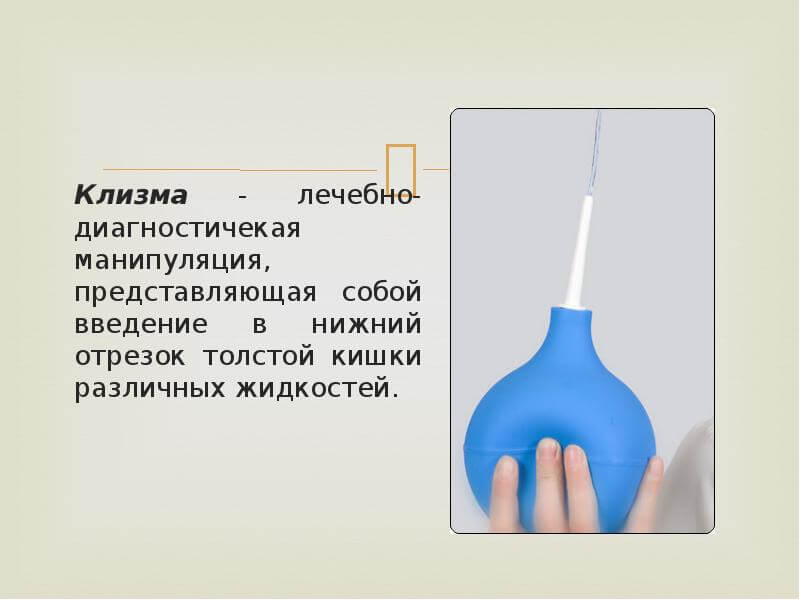
This also includes the introduction of liquids for constipation with the banal purpose of facilitating bowel movements. The volumes vary; both micro- and regular enemas are used for cleansing. After administering the liquid, you need to lie down for at least 10–15 minutes so that the water has time to soften the stool. Otherwise, your efforts will be in vain: water will pour out, but only that...
Hypertensive
The peculiarity is the introduction of a liquid that irritates the intestinal receptors for independent, subsequent relief. To do this, use solutions of magnesia (Epsom or bitter salt, scientific name - magnesium sulfate heptahydrate), soda, ordinary rock salt, and soap. A cold (room temperature) solution is administered, then the laxative effect is stronger. The required irritating effect is not healthy for the body, so you should not get carried away with frequent use.
Starchy
Used for acute colitis. A suspension of a product (potato, rice, wheat or corn - it doesn’t matter) is introduced to weaken peristalsis. This suspension softens feces and at the same time envelops the intestinal walls. Five grams of starch are dissolved little by little in 100 ml of warm water, then 100 ml of hot water is added. The optimal temperature for administration is 38 °C.
Medicinal
Introducing medication into the body by enema instead of the more common oral route has some advantages. They are divided into two groups: administration of drugs with local and general effects. Local – delivery of the drug immediately to the place for illness of the rectum or colon. When drugs with general effects are administered, they are not destroyed in the liver and are not affected by gastric juice. The effect of the drug is stronger, and it is easier to calculate the duration of work. It’s a little strange, but often an enema is less dangerous for the body than simply swallowing a pill with the same drug.
Oil and emulsion
Instead of (or in addition to) water, use olive, sunflower or Vaseline oil. The volumes are small, usually 50–100 ml is enough. The oil or its aqueous emulsion is heated in a water bath to 37–38 °C. The action is slow, so such enemas are often given at night.
Nutritious
Not all substances are absorbed in the large intestine. Water, salts, glucose, weak protein solution (broth). It is problematic to introduce a noticeable amount of nutrients in this way, so such feeding should be considered only as additional, and not a replacement for the main one.
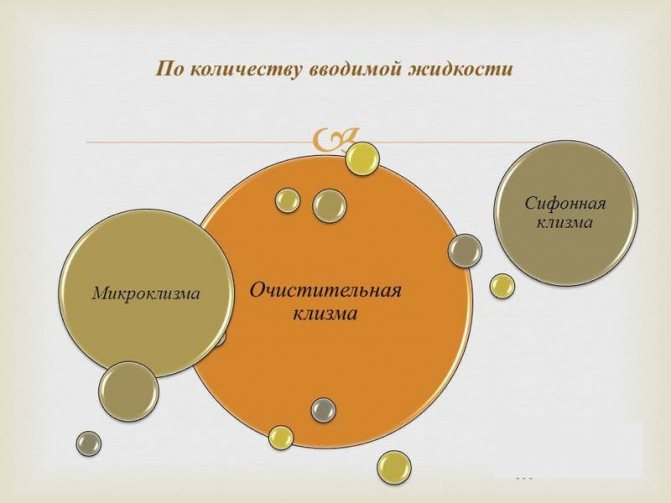
Before use (as in the case of medicinal), first do a cleansing enema. The goal is to remove excess for better absorption of nutrients.
Types and purposes of enemas
Performing an enema does not require strict sterile conditions, so it can be done at home without harm to health. The procedure must be carried out strictly according to the recommendation of the attending physician!
| Type of enema | Purpose of the procedure | Amount of fluid administered | What is introduced | Recommended fluid temperature |
| Cleansing | Cleansing the large intestine from feces | 1000-15000 ml | Water | 25-30 °C (for stimulating the intestines - 12-20 °C, for relaxation - 37-42 °C) |
| Medicinal | Rectal diseases | 50-200 ml | Medicine | 37-38 °C |
| Hypertensive | Persistent and atonic constipation, arterial hypertension | 200 ml | Hypertonic solution (0.5 tablespoon of salt per half glass of water) | 35-37 °C |
| Starchy | For enveloping and softening stool in acute inflammation of the mucous membrane of the small or large intestine | 200 ml | 5 grams starch + water | 38-40 °C |
| Drip | Fluid replacement | 50-2000 ml | Water | 37-38 °C |
| Nutritious | Administration of nutrients rectally if it is not possible to absorb food through the stomach | 200 ml | Nutrient fluid (water, saline or isotonic solution, non-concentrated broth) | 37-38 °C |
| Emulsion | Emptying effect | 50-100 ml | A mixture of fish oil and water (equal proportions) | 37-38 °C |
| Oily | Persistent constipations | 50-100 ml | Sunflower, olive or Vaseline oil | 37-38 °C |
| Siphon | Constipation, intestinal obstruction (if a cleansing enema is ineffective). Siphon enema is performed in a hospital setting | 10-12 liters | Water | 35-36 °C |
In fact, enemas are not as harmless as they seem at first glance. There are a number of contraindications for which they are strictly not recommended.
Doing an enema is prohibited for the following diseases (physiological conditions):
- acute inflammation and ulcers of the rectum;
- peritonitis;
- acute inflammation of the adnexal formation of the cecum;
- bleeding into the lumen of the small or large intestine;
- malignant formation of the rectum (grade 3-4);
- bleeding chronic hemorrhoids;
- defect, wound or ulcer of the mucous membrane of the rectum or anus;
- pregnancy (enema is done according to strict indications);
- rectal prolapse.
If during an enema you feel acute pain in the abdomen, the procedure should be stopped immediately. For patients diagnosed with serious kidney pathology and frequent exacerbations of arthrosis, medical cleansing procedures are prescribed only in extreme cases.
Arrangement of the place and the process itself
In advance, before placing a microenema, prepare the place. Cover the couch (or other flat, not too soft surface) with oilcloth. You can do the enema yourself, although it is more convenient if the procedure is performed by medical staff. When any object is inserted into the anus, you may feel the urge to immediately run to the toilet. This is due to signals from the receptors of the anus, such is the deception of the body. It’s not scary, you need to keep this possibility in mind and warn the patient (especially a child).
The patient lies on his left side, knees and legs bent. We are not in a hurry, since it is correct to administer a microenema without rushing. Sharp and inept insertion of the tip not only causes unpleasant sensations, but can also damage its walls! The tip, lubricated with any oil, is inserted with careful rotational movements. The other hand spreads the buttocks. Direction: first (3–4 cm) – approximately to the navel, then lowered and advanced parallel to the tailbone.
It is possible that during insertion the tip will become clogged with feces. Then we take it out, clean it and reintroduce it. Do not try to break through the plug with pressure! If we feel an obstacle to the movement of the tip (the wall or feces are in the way), then we return it a little back, open the tap for a moment or squeeze out a little liquid, after which we continue insertion. If there are hemorrhoids, we insert between them.
Prostate massage has a beneficial effect on men's potency. If the procedure is prescribed, it is convenient to combine it with washing.
Rinsing with an Esmarch mug
Intestinal lavage using this equipment is also performed with a solution at room temperature in order to obtain the desired effect and avoid discomfort. Before cleaning, the system must be treated with hot water, with a solution of antibacterial or laundry soap, and checked for leaks and faults, including the valve.
You should prepare the place where the patient will be placed - lay down an oilcloth and place a large container (basin, bucket). The required volume of liquid (usually 1-2 liters) is poured into the mug, air is released and the locking device is closed. The patient takes a position on the left side, with his legs tucked towards the abdomen. Before inserting into the hole, the tip of the system must be lubricated with Vaseline.
The lubricated tip is inserted into the anus to a depth of 3-4 cm, tilted according to the position of the spine and carefully inserted another 10 cm, then the valve is unlocked and the system is raised about 1-2 m , for more free access of the solution to the rectum (a higher position facilitates faster introduction). After infusion of the required volume, the valve closes, and the patient will feel the urge to defecate. It is necessary to squeeze the buttocks tightly to prevent the solution from leaking out prematurely.
The emptying process will occur approximately 20 minutes after the procedure. If unpleasant or even painful sensations, dizziness, or vomiting occur, the procedure should be stopped immediately.
At the end of the event, you should refrain from eating and remain at rest for an hour.
Tips, mistakes and important little things when giving an enema
Do not insert the tip deeply, 6-8 cm is necessary and sufficient. Great depth does not affect the spread of fluid through the intestines - it is already quite mobile. And the implementation process itself becomes not only more difficult, but also more dangerous, the risk of injuring the walls increases
- The temperature of the liquid depends on the purpose of the procedure. Cold (14–20 ˚С) water is irritating and is used for hypertensive enema. Warm – relaxing.
- Liquids heated above 40 ˚C cannot be administered - intestinal burns are possible!
- When a solution heated above room temperature is introduced, water begins to be absorbed by the walls. The speed of the absorption process increases with increasing temperature of the liquid.
- The recommendations found to carry out the procedure at night make sense only for oil, partially emulsion microenemas. The body absorbs water precisely from the lower intestine, and the introduction of additional volumes.
Types of enemas
There are several types of this manipulation:
The first type involves washing out feces from the rectum. The procedure requires an Esmarch mug, which is equipped with a rubber reservoir with a tip and a tube equipped with a locking mechanism. The effect occurs after half an hour after administering the solution.
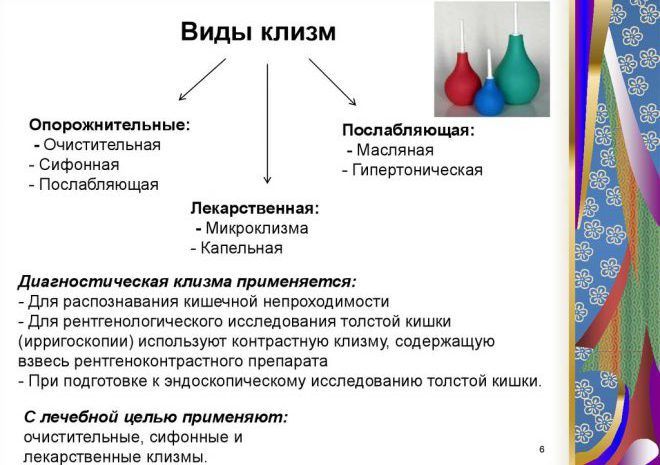
A hypertensive enema is performed for constipation resulting from intestinal pathology. The procedure is carried out using a rubber bulb equipped with a plastic tip. Hypertonic saline liquid is injected into the intestinal lumen, increasing osmotic pressure. This procedure stimulates peristalsis of the intestinal walls and promotes the dilution of fecal formations, thereby improving bowel movements. The result is instant. The liquid acts for 7 minutes.
The third type is an oil enema. The procedure is carried out using a warm oily solution. The oily base envelops fecal stones, which become elastic. The warm solution reduces intestinal spasms, making bowel movements easier. This type is distinguished by a slow effect, which occurs after 11 hours. An oily enema is used for inflammation of the rectum.
But you should know that cleansing the body using such a medical procedure is not suitable for everyone.
Contraindications to enema
Before you do an enema with a syringe at home, you should know under what contraindications the introduction of an enema instrument can be dangerous:
- during menstruation;
- during pregnancy;
- with recent illnesses in which stressful situations for the body are unacceptable;
- with intestinal bleeding;
- for pain in the stomach;
- with elevated temperature, chills and headaches;
- with renal failure;
- for dizziness, vomiting, nausea and general weakness of the body.
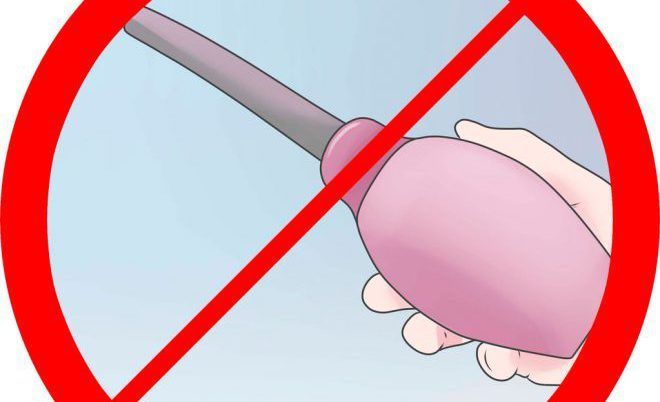
If one of these indicators exists, then the medical procedure is contraindicated.
Opinion about the enema substitute from patients
Glycerin suppositories helped Catherine overcome her psychological fear of going to the toilet after childbirth. She called suppositories “a bullet that hits the target!” The mother of four-year-old Maxim spoke positively about the medicine: after five minutes the child went to the toilet without effort.
Bright orange sea buckthorn suppositories saved 42-year-old Margot from constipation during pregnancy. Particularly noted is the harmlessness to the fetus. Svetlana N. shared her impressions about the use of Bisacodyl emotionally, calling the drug (both tablets and suppositories) “a killer drug.” It began to affect the body within a few minutes. Her advice: saves when all else fails, fast, exactly as described! But don’t partake. Everything is good in moderation.
Sometimes bowel cleansing is required in the absence of the necessary equipment, so many people are concerned with the question of how to do an enema without an enema. The manipulation can be carried out using available materials. It is important to be careful and strictly follow the recommendations to prevent complications.
How to choose an enema bulb?
If it is necessary to administer a solution not exceeding 0.5 liters, then it is more advisable to use an enema bulb. Otherwise, Esmarch's mug is recommended. The pharmacy market offers pears for children. The volume of the tool ranges from 50 to 300 g. You can choose from an enema with a plastic, silicone or rubber tip. Disposable syringes equipped with a special laxative solution have proven themselves to be effective.
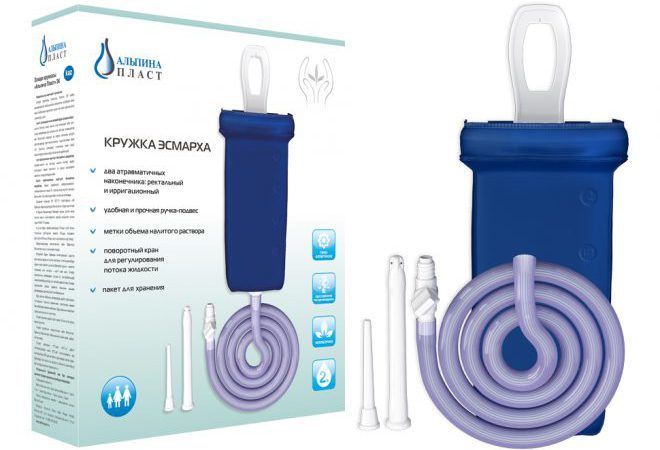
Tips come in three types: plastic, rubber and silicone. Now pharmacies sell a disposable syringe with a special laxative solution already inside. The standard volume of a pear is quite enough for an adult. Therefore, many people suffering from constipation keep this medical instrument in their home medicine cabinet.
For a cleansing enema, it is best to use an Esmarch mug, since its volume is quite sufficient for such a procedure. One of the methods of cleansing the body is an enema. This procedure was practiced many centuries ago as a treatment for the gastrointestinal tract and remains relevant today.
How to give yourself an enema with a syringe at home? Carrying out the procedure on your own is not an easy process. It requires careful preparation and certain skills. Before the cleansing procedure, you should know the volume of solution required for administration, as well as what instrument and type of enema is needed.
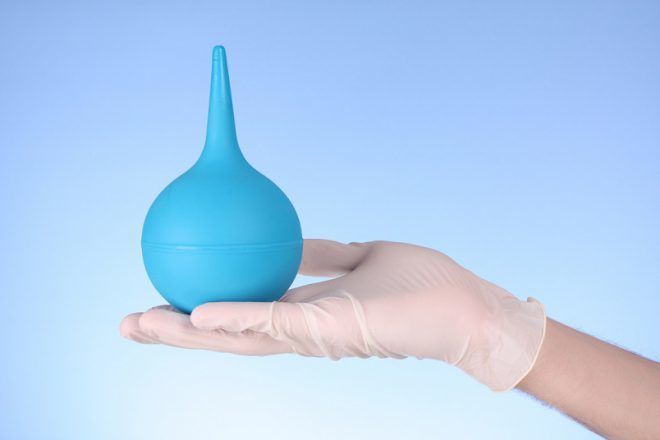
Which is better: Esmarch's mug or pear?
The pear is convenient to use when administering a small amount of liquid up to half a liter, which is important for a child. To carry out a full procedure for an adult, if more liquid is required, it is better to use an Esmarch mug. For independent use, take a bulb; it is easy to use and one slow press is enough to introduce all the liquid.
To manipulate the mug, you will need outside help; you will need to hold it at a height of up to 1.5-2 m. You will need to regulate and deflate the air using a faucet, which is impossible when used independently.
To carry out cleaning at home yourself, a rubber bulb will do the job better. You should not overuse an enema; it can cause a decrease in peristalsis and leaching of beneficial microflora, which leads to chronic constipation. Reasonable use will improve the body without harm to health.
Sometimes bowel cleansing is required in the absence of the necessary equipment, so many people are concerned with the question of how to do an enema without an enema. The manipulation can be carried out using available materials. It is important to be careful and strictly follow the recommendations to prevent complications.
Preparatory stage
To administer an enema yourself, you should prepare the following materials:
- douching tool;
- liquid or solution in the required volume;
- Vaseline or baby cream;
- oilcloth.
The composition of the solution depends on what type of enema is used. Before the procedure, the bulb and tip must be washed well in a soapy solution. If you use plain water for douching, it should have a temperature of no more than 35 degrees. If glycerin or olive/sunflower oil is added to the water, then the proportion should be as follows: 1 tbsp. spoon for 0.5 liters of water.
Oil enema
For constipation, you can use an oil enema. It quickly and gently cleanses the intestines. The oil helps move feces towards the anus. To carry out the procedure, you need to prepare vegetable or pharmaceutical oil. The solution should be heated to 36–370C. Warm oil relaxes the intestines and eases cramps.
You should know that the oil enema has a delayed effect. With a volume of 15–100 ml, the effect is achieved after 5–12 hours. Carrying out a standard cleansing enema requires the use of water at room temperature. With a liquid volume of 1–2 liters, the action time is from 15 to 30 minutes.
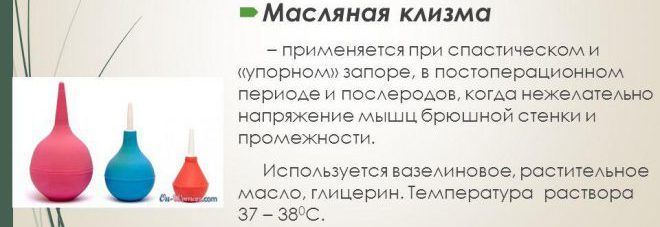
Types of enemas
Classification is carried out according to the following factors:
- by method of implementation;
- according to the main purpose;
- by volume of injected solution;
- by liquid temperature;
- by chemical composition.
Types by purpose
Depending on the purpose of the manipulation, enemas are distinguished:
- cleansing - the most common type, often used at home, in hospitals before diagnostic tests, therapeutic, and surgical procedures;
- laxatives - used for constipation;
- nutritious (drip) - in the absence of the possibility of taking nutrients orally;
- medicinal - have a local therapeutic effect on the lower intestines.
Each type is used strictly according to indications.
Classification according to volume
Depending on the volume of liquid used, there are:
- microenemas - no more than 100 ml;
- standard (cleaning) - 1.5 - 2 l;
- siphon - a maximum of 20 liters (in total) is injected per session, 1 - 2 liters per infusion.
Carrying out douching at home
If all the instruments are prepared, you need to take the correct posture to easily administer the liquid. For microenemas, it is better to use a syringe, that is, a bulb. If it is necessary to completely cleanse the intestines, an Esmarch mug enema is recommended. The procedure is as follows:
- choose a comfortable position for yourself;
- check if the tip is damaged;
- lubricate the tip with cream or Vaseline;
- insert the instrument to a depth of no more than 10 cm;
- squeeze the bulb so that the liquid is evenly distributed in the rectum;
- give a light abdominal massage.
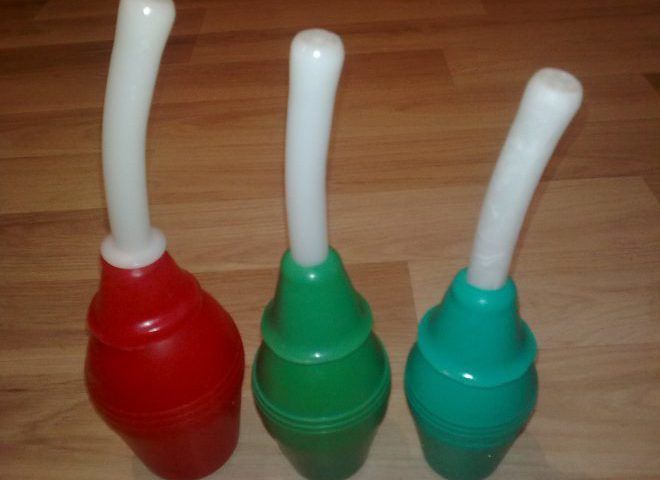
If you experience a sudden urge to defecate, raise your pelvis above head level. After administering the enema, you must wait 15 minutes before you can go to the toilet. During the procedure, listen to your body. If you feel discomfort, you should stop douching.
The frequency of repetition of the procedure is determined by the result you want to get. For example, the number of therapeutic enema procedures is prescribed by the doctor. When cleansing the intestines for the purpose of weight loss or for prevention, an enema is administered no more than once a week. Frequent procedures can harm the body - this is rectal dysbiosis, microflora disturbance, burns and intestinal trauma. To avoid such violations, it is better to consult a doctor about the number of douching sessions.
How to do an enema correctly?
- The syringe is sterilized by boiling. In this case, you must first fill it with water;
- Fill the balloon with water or medicine, turn the tip up and release the air;
- Lubricate the tip generously with Vaseline or oil;
- Insert the tip into the rectum 2-3 cm (children in the first days of life) or up to 5 cm (for older children and adults).
The most physiological position for an adult to perform an enema procedure, from a medical point of view, is the position on the left side with the knees pulled up to the chest.
For infants, their legs are raised up so that the child does not push water out of himself during the procedure. You must also remember that you must wait 5-10 minutes after this procedure, despite the urge to defecate, otherwise the expected effect of the enema will not occur. It is also worth mentioning the temperature of the water, which should be close to the temperature of the human body.
Enemas are used in our time to achieve many goals, and it is not difficult to administer it at home, but you must remember that before carrying out this procedure you should definitely consult a doctor.
https://youtube.com/watch?v=iOPa9pePrQk
There are medical indications that require bowel cleansing with water, rinsing with solutions based on herbs or oils. In such cases, you need an enema bulb. This need arises in case of poisoning, constipation, and inflammatory processes of the colon.
You can carry out the cleansing procedure in a hospital, or do a pear enema at home.
